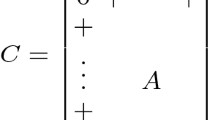Abstract
An algorithm called a Hamming scan was developed recently for obtaining sequences with large merit factors and is adopted here to obtain such sequences within which there are nontrivial segments of large merit factors. Correlative detection of the return signal can be based simultaneously on the entire sequence and its segments with large merit factors. Such a coincidence detection scheme can be characterized by a Schur merit factor of the sequence. Sequences with large Schur merit factors are listed.
Similar content being viewed by others
References
Bernasconi J 1987 Low autocorrelation binary sequences: Statistical mechanics and configuration space analysis.Proc. IEEE 74: 366
Boehmer M A 1967 Binary pulse compression codes.IEEE Trans. Inf. Theory IT-13: 156–167
De Groot C, Wurtz D, Huffman K H 1992 Low autocorrelation binary sequences: exact enumeration and optimization by evolutionary strategies.Optimization 23: 369–384
De Jong K A 1985 Genetic algorithms: a 10 year perspective. InProc. First Int. Conference on Genetic Algorithms (ed.) J J Grefenstette (Hillsdale: Lawrence Erlbaum) pp 169–177
Golay M J E 1961 Complementary series. IEEE Trans. Inf. Theory IT-7: 82–87
Golay M J E 1977 Sieves for low autocorrelation binary sequences.IEEE Trans. Inf. Theory IT-23: 43–51
Golay M J E, Harris D 1990 A new search for skew-symmetric binary sequences with optimal merit factors.IEEE Trans. Inf. Theory 36: 1163–1166
Holland J H 1975Adaptation in natural and artificial systems (Ann Arbor: University of Michigan Press)
Holland J H 1992 Genetic algorithms.Sci.Am. 267: 66–72
Michalewicz Z 1992 Genetic algorithms + data structures = evolution programs. (Berlin: Springer-Verlag) p. 255
Moharir P S and Rao K S 1996 Nonbinary sequences with superior merit factors (submitted)
Moharir P S, Venkata Rao K, Varma S K 1984 Barker towers.Electron. Lett. 20: 1027–1029
Moharir P S, Varma S K, Venkata Rao K 1985 Tenary pulse compression sequences.J. Inst. Electron. Telecommun. Eng. 31: 33–40
Moharir P S, Singh R, Maru V M 1996 S-K-H algorithm for signal design.Electron. Lett. 32: 1648–1649
Singh R, Moharir P S, Maru V M 1996 Eugenic algorithm-based search for ternary pulse compression sequences.J. Inst. Electron. Telecommun. Eng. 42: 11–19
Tseng C C, Liu C L 1972 Complementary sets of sequences.IEEE Trans. Inf. Theory IT-18: 644–652
Venkata Rao K, Moharir P S, Varma S K 1986 Doubly co-operative ternary sequences.Proc. Inst. Elecr. Eng. F133: 61–67
Author information
Authors and Affiliations
Rights and permissions
About this article
Cite this article
Rao, K.S., Moharir, P.S. Self-co-operative ternary pulse-compression sequences. Sadhana 21, 775–780 (1996). https://doi.org/10.1007/BF02745369
Received:
Revised:
Issue Date:
DOI: https://doi.org/10.1007/BF02745369




